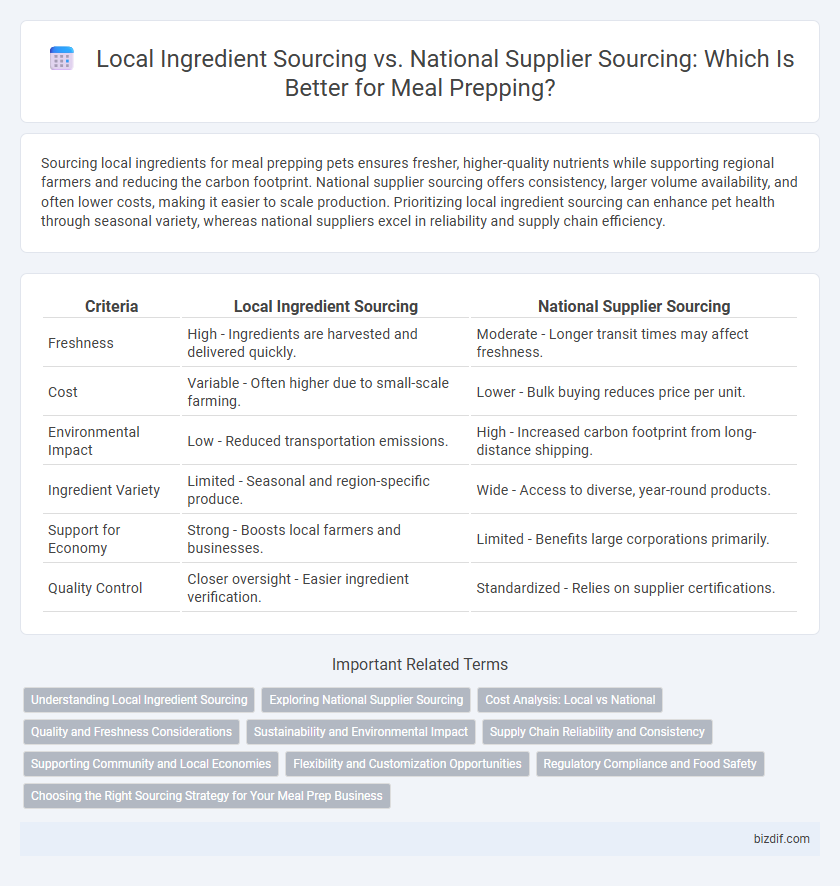Sourcing local ingredients for meal prepping pets ensures fresher, higher-quality nutrients while supporting regional farmers and reducing the carbon footprint. National supplier sourcing offers consistency, larger volume availability, and often lower costs, making it easier to scale production. Prioritizing local ingredient sourcing can enhance pet health through seasonal variety, whereas national suppliers excel in reliability and supply chain efficiency.
Table of Comparison
| Criteria | Local Ingredient Sourcing | National Supplier Sourcing |
|---|---|---|
| Freshness | High - Ingredients are harvested and delivered quickly. | Moderate - Longer transit times may affect freshness. |
| Cost | Variable - Often higher due to small-scale farming. | Lower - Bulk buying reduces price per unit. |
| Environmental Impact | Low - Reduced transportation emissions. | High - Increased carbon footprint from long-distance shipping. |
| Ingredient Variety | Limited - Seasonal and region-specific produce. | Wide - Access to diverse, year-round products. |
| Support for Economy | Strong - Boosts local farmers and businesses. | Limited - Benefits large corporations primarily. |
| Quality Control | Closer oversight - Easier ingredient verification. | Standardized - Relies on supplier certifications. |
Understanding Local Ingredient Sourcing
Local ingredient sourcing involves obtaining fresh, seasonal produce and products directly from nearby farms and producers, ensuring higher freshness and supporting community agriculture. This practice reduces transportation emissions and fosters transparency in supply chains, allowing meal preppers to prioritize quality and sustainability. Emphasizing locally sourced ingredients enhances flavor profiles and nutritional value in meal prepping while strengthening local economies.
Exploring National Supplier Sourcing
National supplier sourcing in meal prepping offers consistent ingredient availability and scalable volume, ensuring reliable supply chains across diverse geographic locations. This approach often provides competitive pricing through bulk purchasing agreements and standardized quality control measures. Leveraging national suppliers enhances efficiency for meal prep businesses aiming to streamline operations and maintain uniform product standards.
Cost Analysis: Local vs National
Local ingredient sourcing often reduces transportation costs and supports regional farmers, resulting in fresher produce and potentially lower spoilage expenses. National supplier sourcing can benefit from bulk purchasing and standardized pricing, offering cost efficiencies and consistent availability across wider markets. Analyzing overall costs requires balancing higher unit prices from local sources against lower logistical costs and valuing freshness and quality in meal prepping operations.
Quality and Freshness Considerations
Local ingredient sourcing ensures superior freshness and higher nutrient retention due to reduced transportation time and minimal storage. National supplier sourcing often offers a wider variety of ingredients but may compromise on peak freshness because of extended shipping and handling processes. Prioritizing local produce in meal prepping enhances flavor complexity and supports seasonal ingredient quality, directly impacting overall meal satisfaction.
Sustainability and Environmental Impact
Sourcing local ingredients for meal prepping significantly reduces carbon emissions by minimizing transportation distances, supporting sustainable farming practices, and promoting seasonal produce. National supplier sourcing often involves extensive logistics and packaging, increasing the environmental footprint compared to local sourcing. Prioritizing local suppliers enhances freshness, decreases waste, and bolsters regional economies committed to eco-friendly agriculture.
Supply Chain Reliability and Consistency
Local ingredient sourcing ensures fresher produce, reduced transportation delays, and stronger supply chain reliability due to proximity and direct supplier relationships. National supplier sourcing offers scalability and consistency in availability but may face risks from longer transportation routes and centralized disruptions. Balancing both methods can optimize supply chain stability for meal prepping needs.
Supporting Community and Local Economies
Sourcing ingredients locally for meal prepping supports small farmers and local businesses, fostering economic growth within the community. Utilizing local produce reduces transportation emissions and ensures fresher, seasonal ingredients, enhancing meal quality. Conversely, national suppliers offer wider variety and bulk availability but often lack the community engagement and sustainability benefits inherent in local sourcing.
Flexibility and Customization Opportunities
Local ingredient sourcing offers greater flexibility and customization opportunities by allowing meal preppers to select fresh, seasonal produce tailored to specific dietary preferences and regional tastes. National supplier sourcing provides consistent availability and standardized products, but may limit ingredient variety and adaptability to unique meal plans. Emphasizing local sourcing can enhance flavor profiles and nutritional value while supporting community sustainability.
Regulatory Compliance and Food Safety
Local ingredient sourcing ensures stricter adherence to regional regulatory compliance and food safety standards due to closer oversight and faster traceability. National supplier sourcing offers standardized certifications and bulk safety protocols but may face challenges in real-time quality control and local regulation variations. Prioritizing local suppliers can reduce risks related to contamination and non-compliance while supporting food safety through fresher, transparently sourced ingredients.
Choosing the Right Sourcing Strategy for Your Meal Prep Business
Selecting the optimal sourcing strategy for your meal prep business directly impacts cost efficiency, ingredient freshness, and customer satisfaction. Local ingredient sourcing often provides fresher produce and supports community farmers, which can enhance flavor profiles and sustainability credentials. National supplier sourcing offers consistent availability and bulk purchasing advantages, crucial for scaling operations and maintaining uniform quality across meals.
Local Ingredient Sourcing vs National Supplier Sourcing Infographic

 bizdif.com
bizdif.com